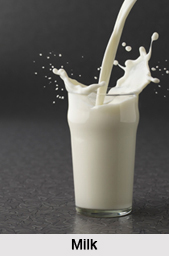 Milk is a white liquid produced by the mammary glands of mammals. All mammals, including humans, will normally produce milk to feed their offspring until they are ready for solid food. It contains valuable nutrients, and it can offer a range of health benefits. Milk is often regarded as being nature"s most complete food. It earns this reputation by providing many of the nutrients which are essential for the growth of the human body. Being an excellent source of protein and having an abundance of vitamins and minerals, particularly calcium, milk can make a positive contribution to the health of a nation.
Milk is a white liquid produced by the mammary glands of mammals. All mammals, including humans, will normally produce milk to feed their offspring until they are ready for solid food. It contains valuable nutrients, and it can offer a range of health benefits. Milk is often regarded as being nature"s most complete food. It earns this reputation by providing many of the nutrients which are essential for the growth of the human body. Being an excellent source of protein and having an abundance of vitamins and minerals, particularly calcium, milk can make a positive contribution to the health of a nation.
Although animals used for milk include cattle, goats, sheep, horses, buffalo, yaks, donkeys and camels, cow"s milk is one of the mildest tasting mammalian milks and the most popular.
History of Milk
Humans first learned to regularly consume the milk of other mammals following the domestication of animals during the Neolithic Revolution or the development of agriculture.
Products of Milk
Dairy products or milk products are a type of food produced from or containing the milk of mammals. Dairy products include food items such as curd, cheese and ghee. A facility that produces dairy products is known as a "Dairy".
Health Benefits of Milk
Milk is an excellent source of vitamins and minerals, particularly calcium. It has long been recognised for its important role in bone health. Nutritionists recommend that milk and other dairy products such as curd and cheese should be consumed daily as part of a balanced diet.
Milk and milk products contain a good balance of protein, fat and carbohydrate and are a very important source of essential nutrients, including:
•Calcium
•Riboflavin
•Phosphorous
•Vitamins A and B12
•Potassium
•Magnesium
•Zinc
Milk products also contain "high-quality proteins" that are well suited to human needs. The health benefits of milk include increased bone strength, smoother skin, stronger immune system, prevention of illnesses such as hypertension, dental decay, dehydration, respiratory problems, obesity, osteoporosis and even some forms of cancer. The beneficial health nutrients obtained from milk are essential for the human body and help prevent a number of chronic ailments.




















